Dorcas (Galley) Hoar was my 8th-Great Grandmother on the Crosby side. In 1692 she lived in the town of Beverly, Massachusetts. Beverly is adjacent to the better known town of Salem.
This is Part 2, in a two-part series, about Dorcas Hoar’s involvement with the Puritan legal system. During her life Dorcas, as a defendant in criminal proceedings, caused many pages of court documents to be generated. A great deal of those documents and transcripts still exist and are available to read on-line. I recommend reading Part 1 first.
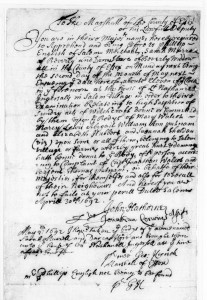
Complaint & Arrest
In the spring of 1692 Dorcas Hoar was living in the town of Beverly, Massachusetts. She was recently widowed after her husband William died suddenly, and some thought suspiciously, during the previous winter. On April 30, 1692 Jonathan Walcott and Thomas Putnam swore out a formal complaint with the court detailing allegations of witchcraft committed by Dorcas and two others. The men charged that the alleged witches were afflicting several local women through the use of witchcraft.
After hearing the testimony of Walcott and Putnam, the court issued an arrest warrant for Dorcas Hoar and the other two accused witches. The warrant ordered the Marshal of the County of Essex to arrest those named in the warrant and bring them before the court on May 2, 1692. Dorcas and the others were to be examined for crimes “relating to high suspicion of sundry acts of witchcraft, done or commanded so by them, upon the bodies of Mary Walcott, Mary Lewis, Abigail Williams, Ann Putnam, Elizabeth Hubbard and Susannah Sheldon.”
Arraignment
On May 2, 1692 the Marshal of Essex County, George Herrick, brought Dorcas Hoar before the court. The judges of the court were John Hathorne and Jonathan Corwin. These men were the judges in most of the Salem witch trials and had already convicted and condemned several other accused witches on the basis of “spectral evidence.” Claims that an apparition of the accused appeared to the victim and that the apparition menaced or assaulted them in some way was considered spectral evidence. Such evidence was permitted in court and many times was the only evidence needed to convict.
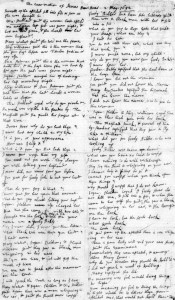
The official record of Dorcas’ examination mentions that as soon as she was led into the court “several of the afflicted fell into fits on the floor.” Elizabeth Hubbard, the first of the victims to testify, accused Dorcas of “afflicting” her since Dorcas had choked her husband to death, during the previous winter. Three others made similar allegations against Dorcas.
During the precedings Elizabeth Hubbard, one of Dorcas’ accusers, cried out in court, “Why do you pinch me?” The records of the court session indicate that the mark on Elizabeth was visible to bystanders. Adding credence to the theatrics was Marshal Herrick who claimed seeing Dorcas moving her fingers in a pinching fashion.
During her examination by the court Dorcas was challenged with the spectral evidence:
- Court: Dorcas Hoar why do you hurt these?
- Dorcas: I never hurt any child in my life.
- Court: It is you, or your appearance.
- Dorcas: How can I help it?
- Court: What do you say about killing your husband.
- Dorcas: No, I never did, I never saw thee before.
- (Susan Sheldon also charged that Dorcas had consorted with black cats.)
- Court: What black cats were those you had?
- Dorcas: I had none.
- Court: Mary Walcot, Susan Sheldon & Abigail Williams said they saw a black man whispering in your ears.
- Dorcas: Oh! you are liars, & God will stop the mouth of liars.
- Court: You are not to speak after this manner in the Court.
- Dorcas: I will speak the Truth as long as I live.
- Court: What do you say to those cats that suckt [sic] your breast, what are they?
- Dorcas: I had no cats.
- Court: You do not call them cats, what are they that suck you?
- Dorcas: I never suckt [sic] none, but my child.
- (The record also shows that several other persons claimed to have witnessed Dorcas consorting with animals.)
- Court: What can you have no heart to confess?
- Dorcas: I have nothing to do with witchcraft.
- Court: They say the Devil is whispering in your ear.
- Dorcas: I cannot help it if they do see it.
- Court: Cannot you confess what you think of these things?
- Dorcas: Why should I confess that I do not know?
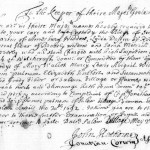
The transcriber of the official court record, Sam Paris, made a notation on the record: “The afflicted were much distressed during her examination.”
Dorcas was ordered to be held until her trial for “High Suspicion of Sundry Acts of Witchcraft” and was committed to the jail in Boston.
Indictment
On July 2, 1692 the court determined there was enough evidence to proceed to trial against Dorcas. Two indictments were reached, each charging Dorcas with practicing the “Detestable Arts called Witchcraft and Sorceries Wickedly.” Indictment number one was for the crimes committed against Elizabeth Hubbard, and indictment number two named Mary Walcott as the victim.
(Links to the indictments are at the end of this article.)
Trial
The trial of Dorcas Hoar was held September 6, 1692 in the village of Salem. The testimony of 18 people, all for the prosecution, was received by the court. There is no mention of testimony being presented in the defense of Dorcas.
Several of the witnesses testified that Dorcas appeared before them in the form of an apparition and tormented them mentally and physically. Dorcas was accused of pinching, biting and “nearly pulling bones from their joints” by the young women.
Testimony was also presented by witnesses claiming to see Dorcas in possession of a palm reading book. Such a book was considered evil at the time and the possessor was often viewed as a cohort of the devil.
Mary Walcott, who was about 17-years-old, testified that on the day of Dorcas’ arraignment she was tormented in court by Dorcas. Mary claimed that Dorcas nearly choked her to death during her testimony. Mary was one of the women who fell to the floor in fits went Dorcas was brought into her arraignment.
John Hale testified about Dorcas’ criminal past, telling of her involvement during 1678 in a burglary ring and that during that time she threatened the use of dark magic against any who told of her crimes. (See Part I to learn about Dorcas’ criminal past.) John Hale also testified that for several years there were stories told that Dorcas was a fortuneteller and that she told her own fortune. Dorcas said that as long as her husband, William, shall live she would live poorly and if her husband should die she would live a better life.
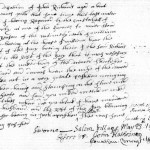
John Richards, Constable of Beverly, testified that he was one of the jurors assigned to investigate the death of William Hoar (Dorcas’ husband) during the previous winter. When the jurors requested to view William’s body naked Dorcas flew into a rage and stomping her feet said, “You… wicked wretches what do you think I have murdered my husband?” Richards stated that Dorcas continued to protest with great passion until the jurors canceled the request to view William’s body. Others also testified about Dorcas’ strange behavior at the time of William’s death.
The court convicted Dorcas for the crimes of witchcraft and set September 9th as the day of her sentencing.
Sentence
September 9, 1692: Dorcas Hoar was sentenced to death by the court. On the same day five others were also sentenced to death. All were convicted of witchcraft and all were to be hanged on September 22, 1692.
“Eight Firebrands of Hell” Hanged
“After the sheriff had done his part in the affair, Rev. Nicholas Noyes, of Salem, turned toward the suspended bodies of the condemned, and said: “What a sad thing it is to see eight firebrands of hell hanging there.” — September 22, 1692.
On September 22, 1692 eight people — 6 women and 2 men — were hanged in Salem; all were convicted of witchcraft. Four of those executed were condemned on September 9th. However, Dorcas was not among those hanged.
The day before her scheduled execution, Dorcas confessed to being a witch and asked for a one-month stay of execution so that she may pray for redemption of her soul. On September 21, 1692 a petition signed by Rev. John Hale, Rev. Nicholas Noyes, Daniel Epps and John Emerson was sent to the court asking for a temporary reprieve for Dorcas, for the sake of redeeming her soul.
Bartholomew Gedney, an officer of the court, issued the temporary stay of execution. On the petition he wrote: “Having heard and taken the confession of Dorcas Hoar does consent that her execution be respited until further order.”
“Only one Woman Condemned, after the Death Warrant was signed, freely Confessed, which occasioned her Reprieval for sometime; and it was observable, This Woman had one Lock of Hair, of a very great length, viz. Four Foot and Seven Inches long, by measure, this Lock was of a different colour from all the rest, (which was short and grey) it grew on the hinder part of her Head, and was matted together like an Elf-Lock; the Court ordered it to be cut off…” — Reverend Deodat Lawson, during a 1692 sermon at a Salem church.
On October 12, 1692 Gov. Phips ordered an end to the arrests and trials for people accused of witchcraft. The governor also ordered the release from jail of persons being held for crimes of witchcraft and for persons who were already convicted. The exact date of Dorcas’ release from jail is not known; however, during January 1693, 49 of the 52 accused witches were released from jail.
Epilogue
What became of Dorcas after her release from jail is unknown. No other records pertaining to her, while living, have been found. On September 13, 1710 Annas King, Dorcas’ daughter, requested that restitution be made for the property seized from Dorcas upon her conviction. The inventory of property seized included two cows, a mare, a bed, bedding, curtains and other household items. The grand total of property seized was 21 pounds 17 shillings.
On December 17, 1711 Dorcas was compensated the full amount of 21 pounds 17 shillings. By this time, however, Dorcas had died so several of her children shared the payment. No record of Dorcas’ death has been found.
My Lineage from Dorcas Hoar:
Dorcas (Galley) Hoar > William Hoar Jr. > Abigail (Hoar) Grover > Rebeckah (Grover) Elwell > Rebecca (Elwell) Crosby > Edward Crosby III > John Crosby > John A. Crosby > Roy Crosby > Maurice Crosby > Me.
——————————
Sources
- People Accused of Witchcraft in 1692: Dorcas Hoar of Beverly — a checklist for all documents pertaining to Dorcas Hoar.
- Records of Salem Witchcraft, Volume 1, W. Elliot Woodward
- Records of Salem Witchcraft, Volume 2, W. Elliot Woodward
- Salem Witch Trials, Documentary Archive and Transcription Project
- Salem Witchcraft Papers, Volume 2: verbatim transcripts of legal documents…
- Indictment Number 1, Dorcas Hoar (original document)
- Indictment Number 2, Dorcas Hoar (original document)
- Dorcas Hoar, Wikipedia
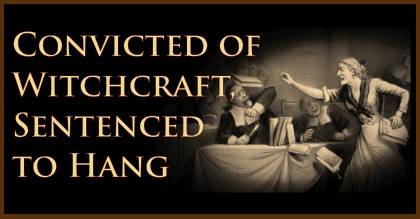
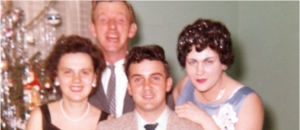
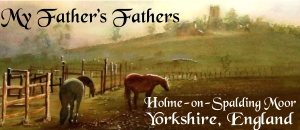
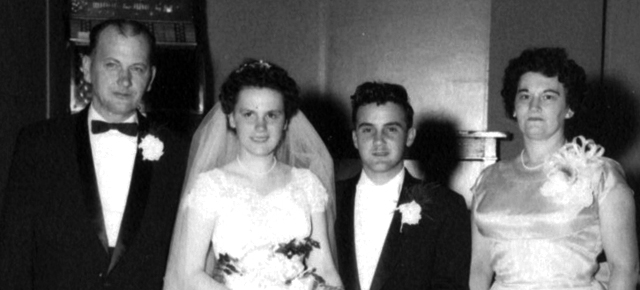


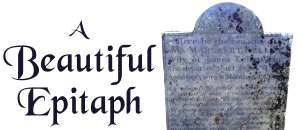
Can you tell me the names and birth dates of all the children of Annis( Annice) Hoar and her husband John King? Do you have any information on their descendants?
Thank you